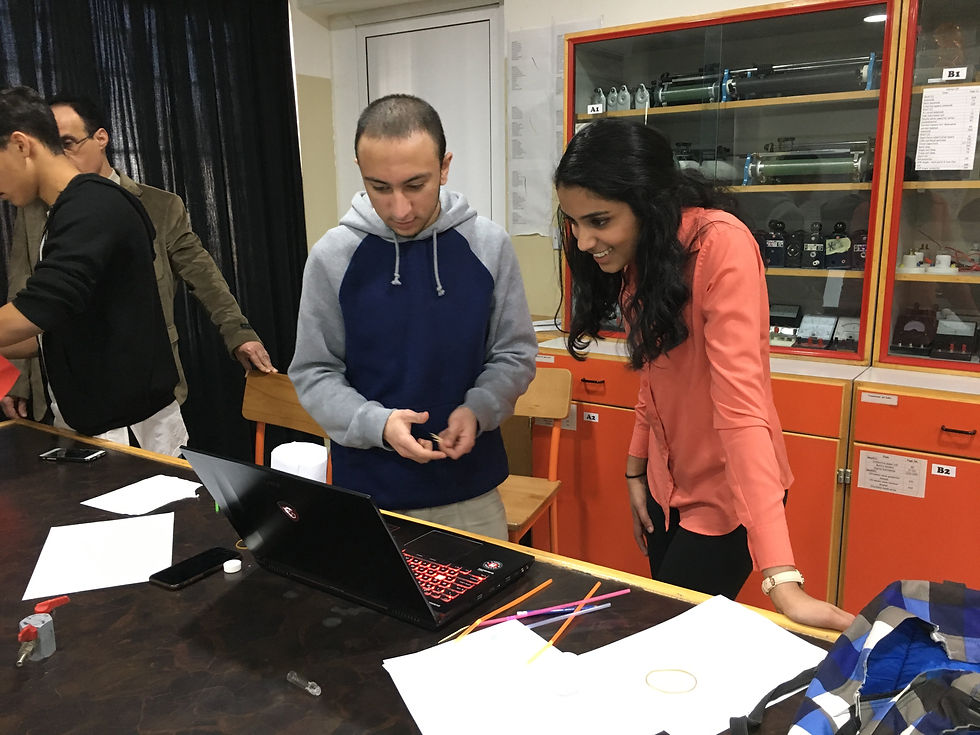Our Curriculum
- Admin
- Jan 29, 2018
- 3 min read
Updated: Feb 1, 2018
By: An Jimenez
You must be wondering: “So, what exactly are these MIT kids teaching the students?”
Well, we’ve taught our curriculum four times now (once at Amman Academy and three times at Jubilee), and we’ve perfected our lesson plans over the last couple weeks to make sure the students get the most out of each lesson. Essentially, each one of us is a “master” of a subject, and that is the subject we make lesson plans for and teach to the students. Here’s a little bit more about each of the four subjects:
An Jimenez - Discrete Mathematics

In Discrete Math, the students cover the following fundamental topics: what is discrete math and why it is important, mathematical statements, logical connectives (and, or, if..then…, if and only if, not), truth tables, translations, binary numbers (how to read and write in binary and why binary is important). We also cover interesting subjects in discrete math such as: cryptography (substitution ciphers, pigpen cipher, rosicrucian cipher, creating a key, encryption and decryption), game theory (prisoner’s dilemma, payoff matrix, Nash equilibrium, dominant strategy), and graph theory (defining a graph, Dijsktra’s algorithm). Each topic has at least one activity to make the lessons more engaging and interactive. Some activities include: Guess 2/3 of the Average, For the Common Good (toothpick game related to natural resources), Crack the Code, Monty Hall Problem, Binary Number Race, and more.
Discrete mathematics is a branch of math related to logic and reasoning rather than memorization, and it serves as the foundation to computer science and logic. It is not a subject that is heavily covered in a typical high school math track (algebra, geometry, pre-calculus, calculus); however, I find the subject incredibly interesting and applicable as it is based on “real-world” mathematics (ex. economic markets, chess, politics, elections).
Srimayi Tenali - Introduction to Building

"In Intro to Building, students understand and explore the design process. The lessons were divided into two sections: how to build (CAD, CNC Machining) and what to build (Product Design, Engineering Design Process). Through a combination of hands-on activities and presentations, students tackle key issues in Amman and develop feasible, innovative solutions. Key activities were the egg drop, where students design safety capsules for eggs to be dropped with limited materials, and a pitch competition where students present start-up ideas to a classroom of "investors.” We also covered basic electrical engineering. Students are introduced to various circuit elements beyond basic ones (transistors, diodes, capacitors) and explore circuit analysis.
Building lessons culminated with Arduino lessons, beginning with lighting an LED, controlling a speaker, and programming a button. Students combined programming lessons with this to design their own projects. Intro to Building aims to equip students with a problem-solving mindset as well as basic mechanical and electrical building skills."
Lucy Li - Introduction to Python

"In Introduction to Python, students learn the fundamentals of coding in Python; these include important concepts such as variables, if statements, for and while loops, along with a general idea of what computer science is and the real world applications of it. With numerous exercises throughout the week, students started from using print statements to draw an image, and ended Python lessons by coding their own game. Through these activities, students were able to both demonstrate their understanding of the material and showcase their creativity in the programs they coded.
These programming in Python lessons segued to teaching Arduino, beginning with lighting an LED, controlling a speaker, and programming a button. Students were equipped with a foundation in computational thinking and were able to learn C/C++. They combined building lessons with this to design their own projects. In this course, students were able to grasp a solid foundation in programming concepts and apply them in practical ways through Python and Arduino."
Sheila Baber - Environmental Science

"Environmental science covered ecology, water conservation, and urban planning--all tailored to be relevant to Jordan. In ecology, students learned about the basics of ecosystems, biogeochemical cycles, energy flow, different types of habitats in Jordan, and biodiversity (through the game "Can you guess if this animal lives in Jordan?"). There was an outdoor component where students measured the biodiversity of their campus using the Shannon Index, and presented their findings to each other. On the second day, students learned about the water cycle, water supply and usage in Jordan, the human impact on natural water bodies, and possible solutions to alleviate water scarcity in Jordan (in an agree/disagree format dealing with options ranging from Red-Dead Conveyance to drip irrigation). Students also held a mock conference between three riparian countries of Palestine, Jordan, and Israel on the issue of sharing the Jordan River. In urban planning, students learned about how cities change over time, waste management, and the role of technology in improving cities. Throughout all three units, lessons were designed to be discussion based and provided students with the opportunity to take ownership of environmental issues in Jordan by generating solutions that take into account unintended consequences of human activity."





Comments